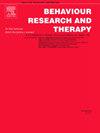恐惧的代价:特定恐惧症的决策障碍。
IF 4.2
2区 心理学
Q1 PSYCHOLOGY, CLINICAL
引用次数: 0
摘要
背景:决策过程可能在特定恐惧症的病因和维持中起关键作用。然而,经验证据有限。这项研究考察了决策是否仅在恐惧相关刺激下才会受损,还是普遍存在的损害在恐惧相关刺激下更为明显。此外,我们检查决策过程的哪些组成部分可能受损。方法:我们使用虚拟决策游戏对蜘蛛恐惧症组(SP, n = 109)与匹配的健康对照组(HC, n = 81)进行比较。为了利用回避冲突的方法,在受试者之间的设计中使用了与恐惧相关的版本(使用蜘蛛)或非恐惧版本的任务,以衡量与恐惧相关或非恐惧刺激的存在如何与最佳决策(收集奖励)相关联。基于漂移扩散模型,研究了处理能力和谨慎性等潜在决策过程。结果:没有明确的证据表明,在没有恐惧相关刺激的情况下,SP参与者的决策能力相对于HC参与者有一般性的损害,但在有恐惧相关刺激的情况下,SP参与者的决策能力有明显的损害。这些回避决定与SP组处理最佳选择选项的能力降低和谨慎性增加有关。结论:特定恐惧症的决策过程在恐惧相关刺激的存在下特别受损,这可能导致适应不良,代价高昂的回避行为。本文章由计算机程序翻译,如有差异,请以英文原文为准。
The cost of fear: Impairments of decision-making in specific phobia
Background
Decision-making processes may play a pivotal role in the etiology and maintenance of specific phobia. However, empirical evidence is limited. This study examined whether decision-making is only impaired in presence of fear-related stimuli or whether general impairments exist but are more pronounced in the presence of fear-related stimuli. Further, we examine which components of the decision-making process might be impaired.
Methods
We examined a spider phobia group (SP, n = 109) relative to matched healthy controls (HC, n = 81) using a virtual decision game. To tap the approach-avoidance-conflict, either a fear-related version (using spiders) or a non-phobic version of the task was used in a between-subjects design to measure how the presence of fear-related or non-phobic stimuli was associated with optimal decision-making (collecting rewards). Based on drift diffusion modelling, underlying decision-making processes such as processing ability and cautiousness were investigated.
Results
No clear evidence for general impairments of decision-making for SP participants relative to HC in the absence of fear-related stimuli was found, but a strong phobia-specific impairment when fear-related stimuli were present. These avoidant decisions were associated with a reduced ability to process the optimal choice option and increased cautiousness in the SP group.
Conclusions
Decision-making processes in specific phobia are specifically impaired in the presence of fear-related stimuli, which might contribute to maladaptive, costly avoidance behavior.
求助全文
通过发布文献求助,成功后即可免费获取论文全文。
去求助
来源期刊

Behaviour Research and Therapy
PSYCHOLOGY, CLINICAL-
CiteScore
7.50
自引率
7.30%
发文量
148
期刊介绍:
The major focus of Behaviour Research and Therapy is an experimental psychopathology approach to understanding emotional and behavioral disorders and their prevention and treatment, using cognitive, behavioral, and psychophysiological (including neural) methods and models. This includes laboratory-based experimental studies with healthy, at risk and subclinical individuals that inform clinical application as well as studies with clinically severe samples. The following types of submissions are encouraged: theoretical reviews of mechanisms that contribute to psychopathology and that offer new treatment targets; tests of novel, mechanistically focused psychological interventions, especially ones that include theory-driven or experimentally-derived predictors, moderators and mediators; and innovations in dissemination and implementation of evidence-based practices into clinical practice in psychology and associated fields, especially those that target underlying mechanisms or focus on novel approaches to treatment delivery. In addition to traditional psychological disorders, the scope of the journal includes behavioural medicine (e.g., chronic pain). The journal will not consider manuscripts dealing primarily with measurement, psychometric analyses, and personality assessment.
 求助内容:
求助内容: 应助结果提醒方式:
应助结果提醒方式:


